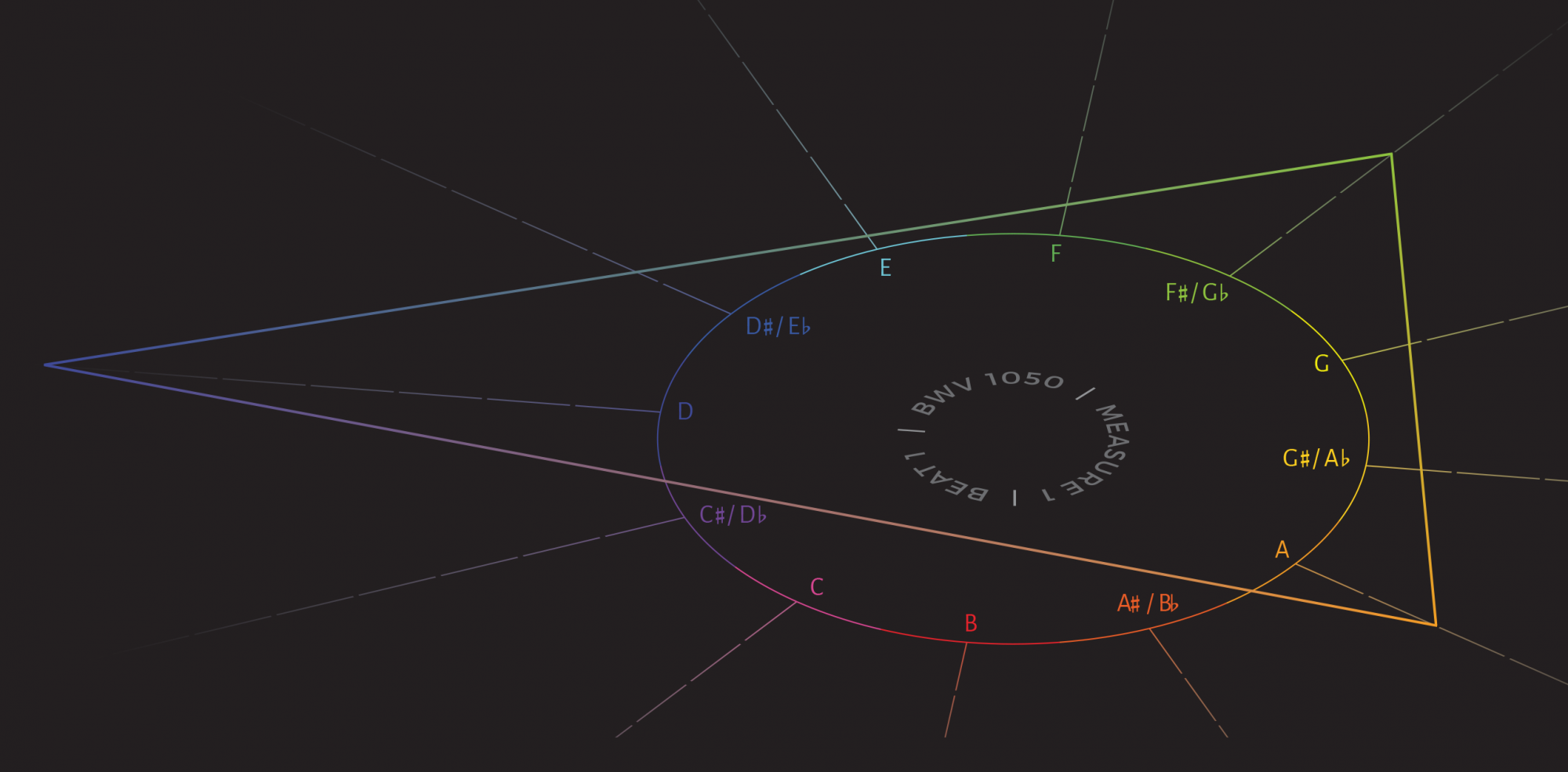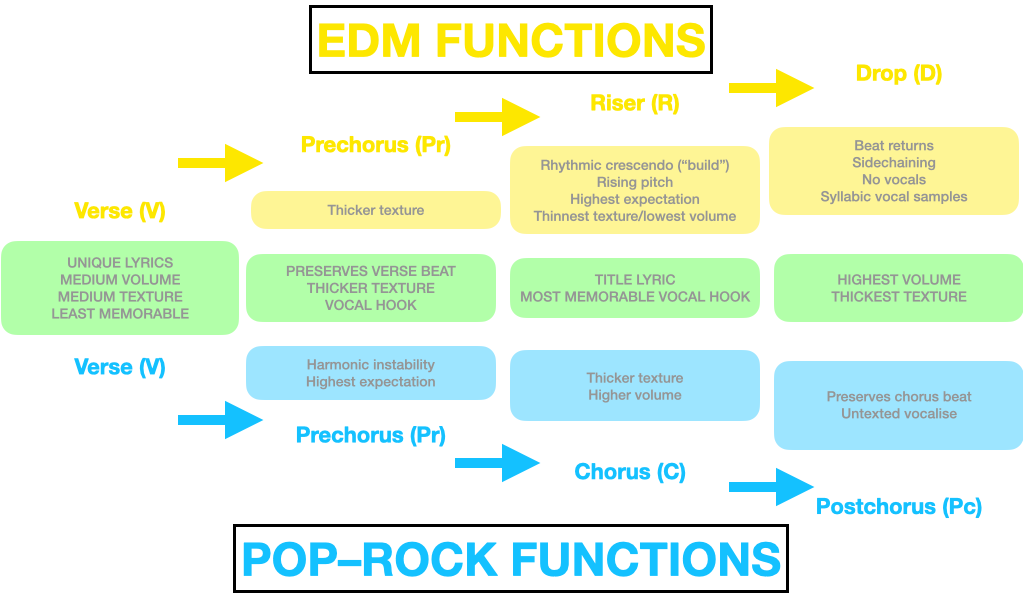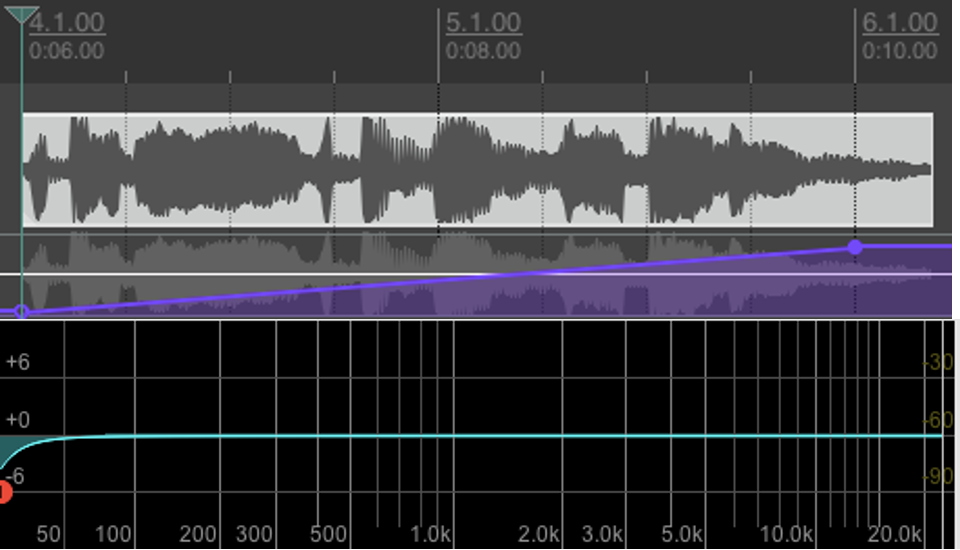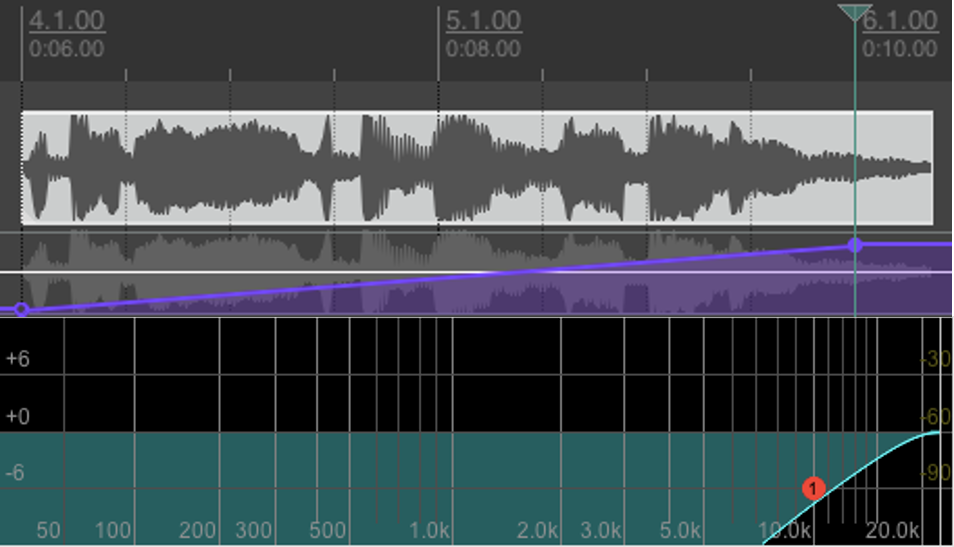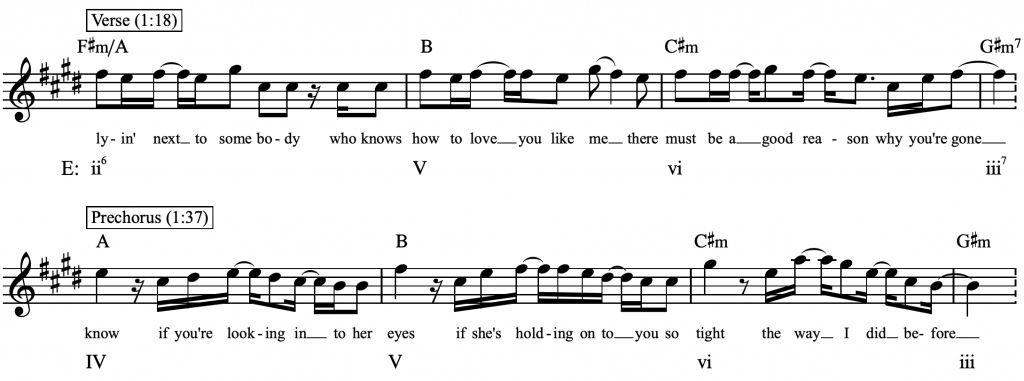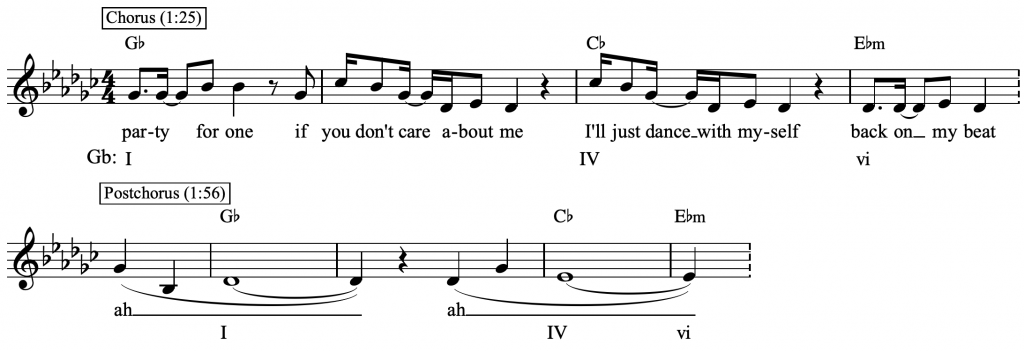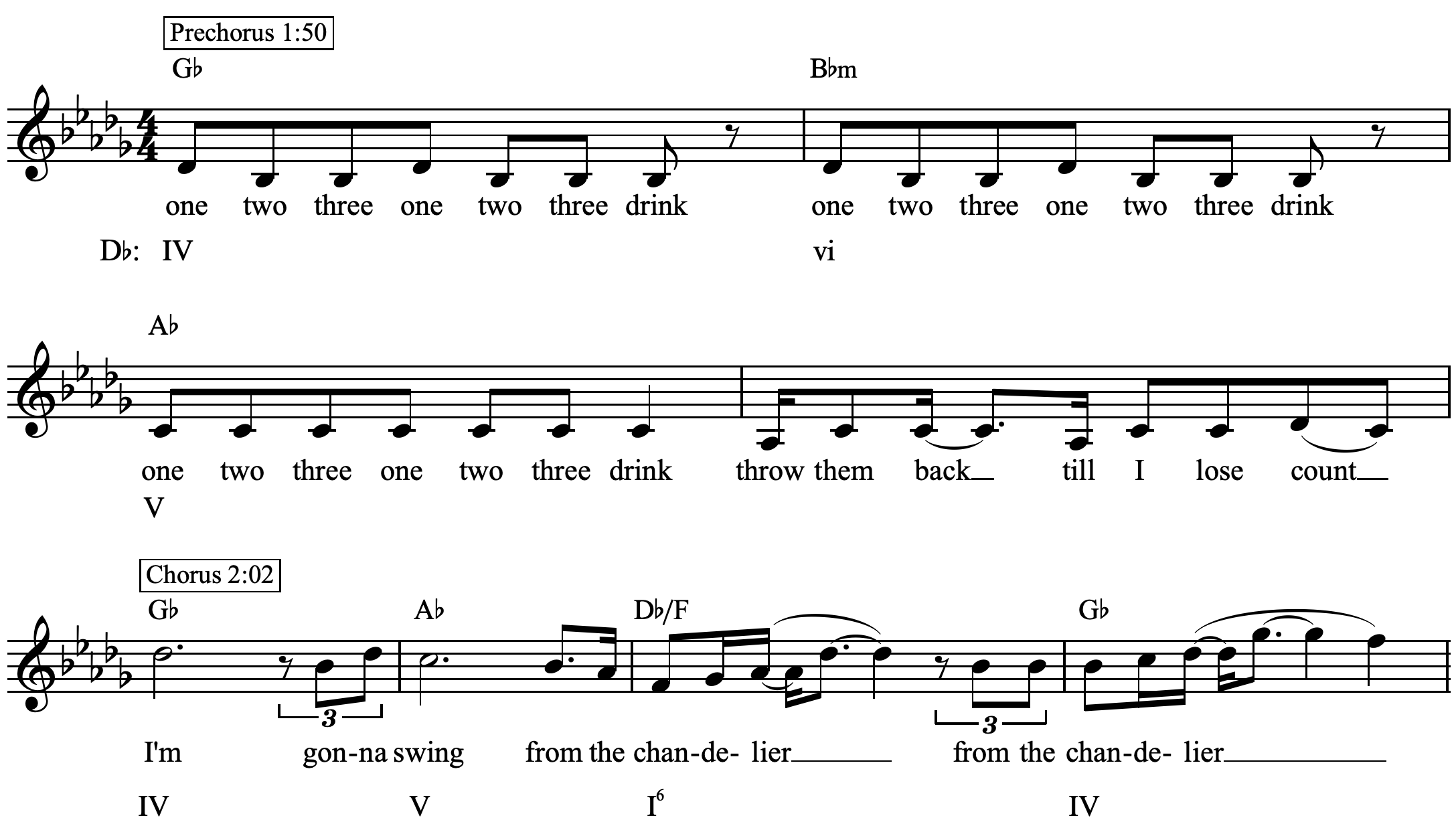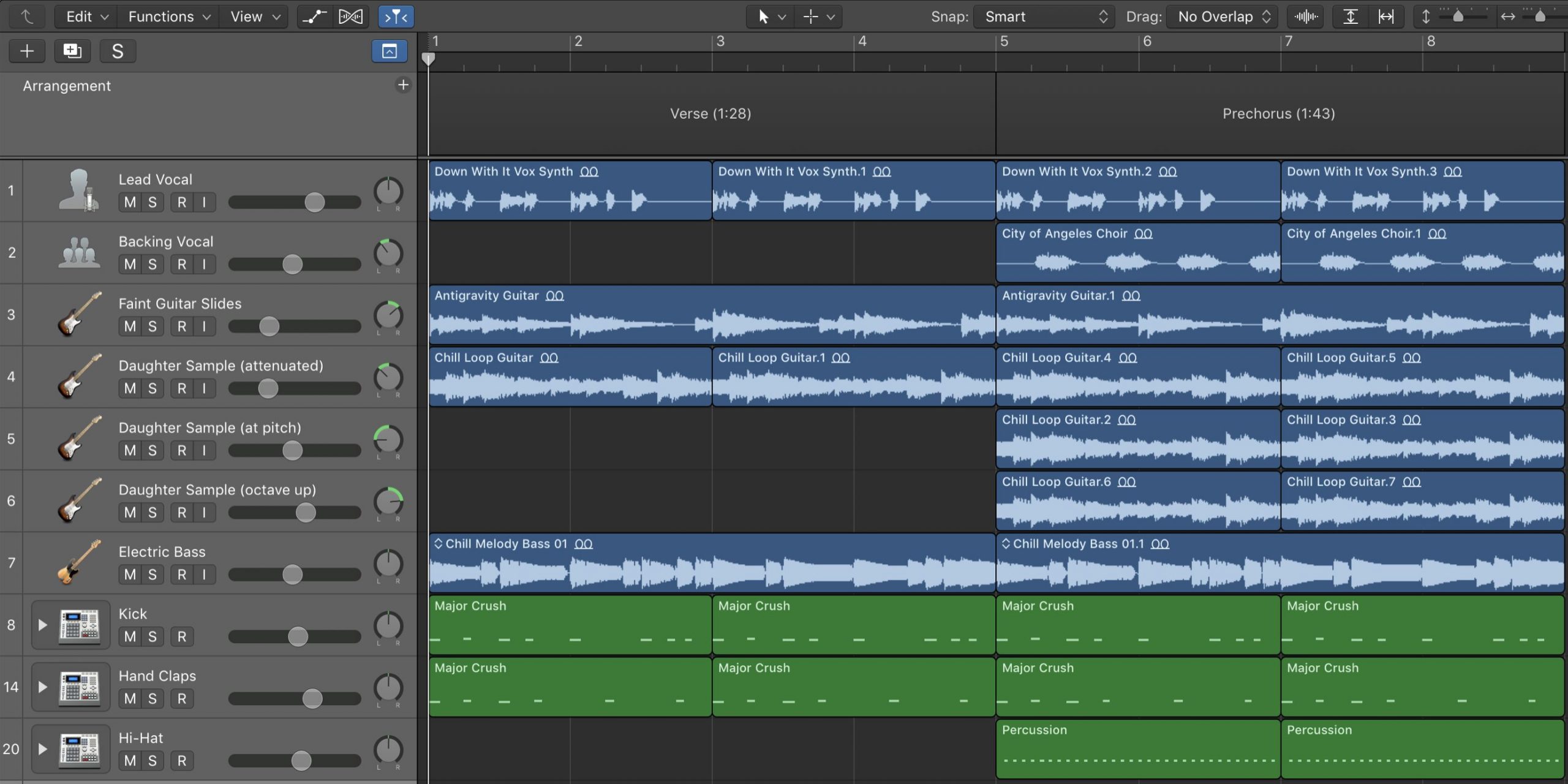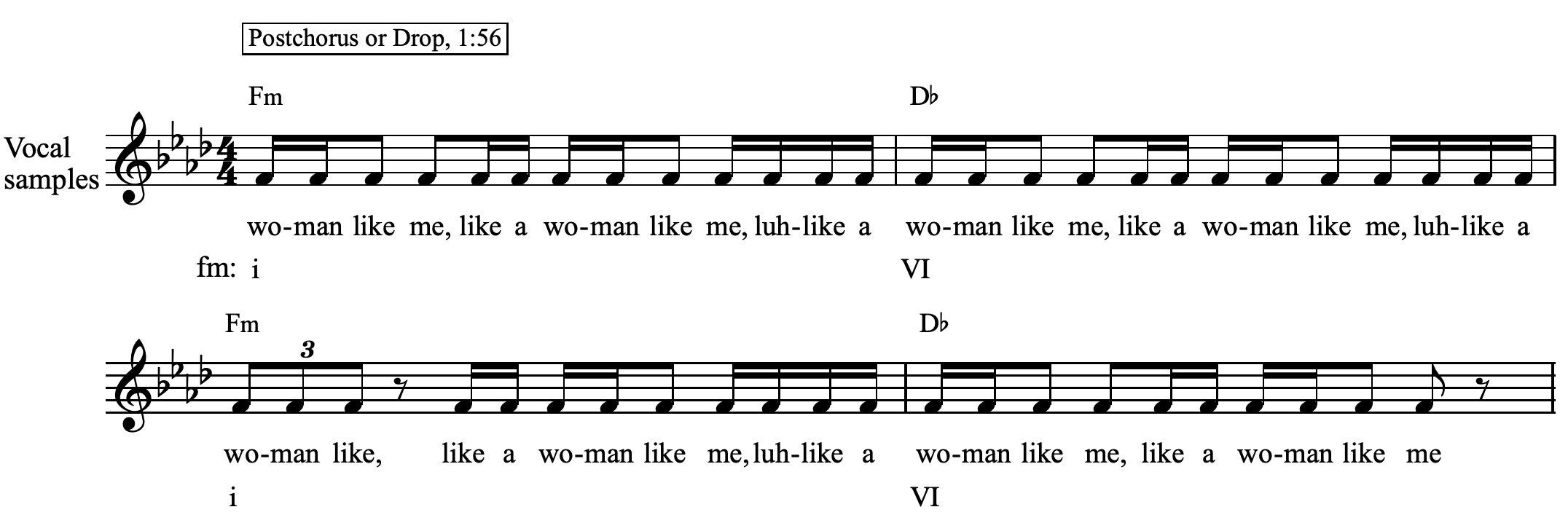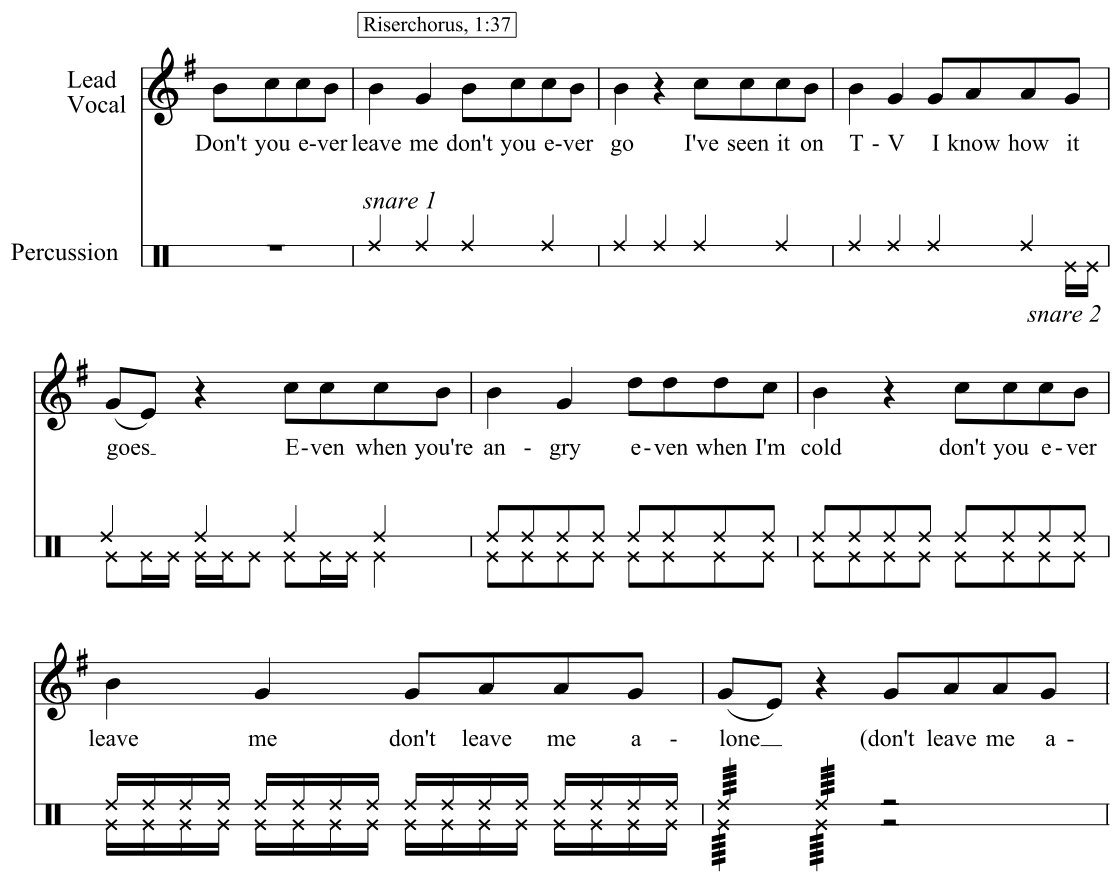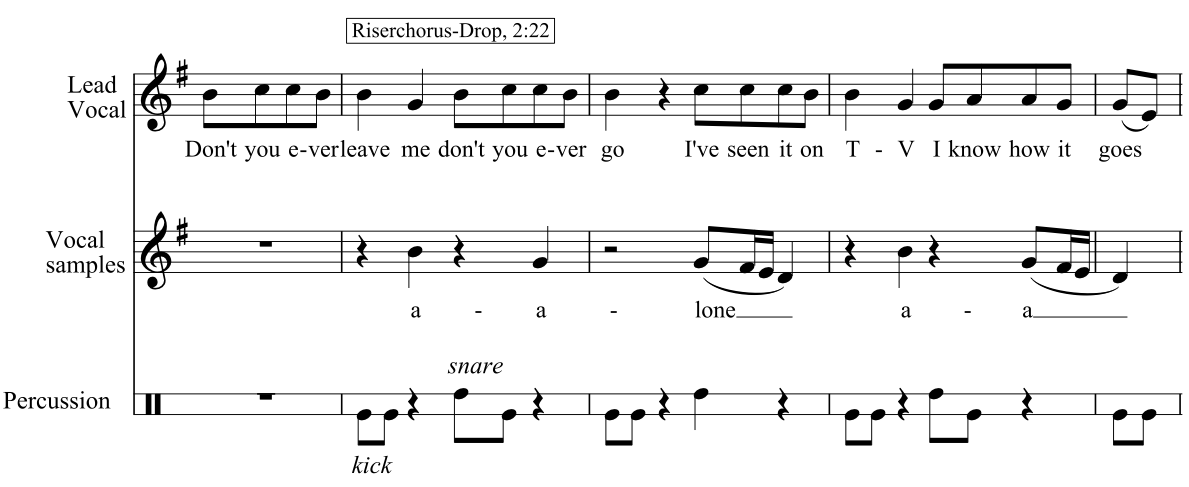Brad Osborn
Abstract
Publications on form in popular music have largely assumed the formal sections germane to pop-rock to be the formal designs of “popular music.” But the most popular music of our time—music charting on the Billboard Top-40—has absorbed the influence of electronic dance music (EDM) in a way that has fundamentally changed its formal structure. This results in “Top-40 EDM,” a genre defined by collaborations between seasoned EDM producers and A-list pop singers.
This article begins by defining EDM’s three core formal functions (verse, riser, and drop), and compares them to more familiar functions heard in pop-rock music (verse, prechorus, chorus, and postchorus). Part two draws on de Clercq’s (2017) concept of blended formal functions to define Top-40 EDM’s most recognizable section, the “riserchorus.” Part three examines the larger structure of these tracks, including their “compound AAA” forms, in which each of the song’s rotations feature the same formal functions, though presented differently. Finally, the article demonstrates how Top-40 EDM producers regularly combine samples at the end of their tracks, resulting in cumulative hyper-blended sections like “riserchorus-bridge” and “riserchorus-drop.”
View PDF
Return to Volume 36
Keywords and phrases: Formenlehre; popular music; riser; drop; sampling
Introduction
Between 2005 and 2013, a number of influential publications on form in popular music assumed the formal sections germane to pop-rock (especially verse, prechorus, chorus, and postchorus) to be the formal designs of “popular music” (Covach 2005; Endrinal 2008; Summach 2011; Doll 2011; de Clercq 2012; Osborn 2013). But just as these publications were gaining traction in the music theory community, the most popular music—music charting on the Billboard Top-401—was absorbing the influence of electronic dance music (EDM) in a way that fundamentally changed its formal structure. Many of these songs are collaborations between an A-list pop singer and a seasoned EDM producer, such as David Guetta, Marshmello, and the highest-paid DJ in the world for six consecutive years, Calvin Harris (Bein 2018).
Prior to 2011, these DJs were making music that was designed for dance clubs rather than Top-40 radio play (Butler 2014). When they began collaborating with pop singers, they imported many of the techniques associated with this dance-focused EDM into radio-friendly pop music. This results in a hybrid genre I call “Top-40 EDM.” Such songs still have verses, and sometimes have prechoruses, but many forego standard pop-rock choruses altogether. Instead, they feature sections that combine the formal functions (Caplin 1998) regularly heard in prechoruses, choruses, and postchoruses with the “riser” and/or “drop” functions associated with EDM since the 1990s (Peres 2016).
Since Caplin’s approach to formal function hinges on harmonic structure, and because harmony is not as useful as sonic density and sonic energy for delineating formal sections in EDM, I instead adopt Asaf Peres’s conception of “sonic function” for the analysis of Top-40 EDM, which follows a “setup-buildup-peak” rotation (2016, 73). Sonic formal function in EDM relies on texture and groove, rather than harmony, to establish the buildup and release of tension.
A remarkable number of scholars in the past five years have also drawn on Peres’s work as a way to make sense of formal functions associated with Top-40 EDM. Most recently, Drew Nobile (2022) has adapted his own initiation–buildup–arrival “telos principle” (itself a variation on Peres’s setup–buildup–peak model) to show how Top-40 EDM songs modify a formal process that has been heard in verse–prechorus–chorus rotations for over 50 years now. In an earlier article from that same year, Cara
Stroud (2022) posited that a useful way to think about Top-40 EDM’s formal innovations was through the lens of two different types of postchoruses: the “codetta-type” and “anthem-type.” Alyssa Barna’s (2020) contribution recast the discussion of form in EDM through the lens of embodiment. For Barna, the most climactic moment in an EDM track is the “dance chorus” (what EDM musicians refer to as the drop). By decreasing emphasis on lyrics and increasing emphasis on groove and sonic intensity, this section invites listeners to actively dance rather than passively listen. In a recent issue of this journal, Kyle Adams (2019) has also explored formal sections in EDM using texture, rather than harmony, as a means of distinguishing formal sections. Adams also investigates intertextuality in EDM tracks, discussing specifically how remixes or cover versions maintain, alter, or obscure formal sections in relation to the original release.
My approach to analyzing form in Top-40 EDM benefits from these recent contributions by Adams, Barna, Stroud, and Nobile, while also placing renewed focus on Peres’s original 2016 theory in which texture and gesture are the delineating factors in recognizing formal sections and describing formal function. By continually comparing EDM and pop-rock formal functions I also generate a nuanced taxonomy for describing form in Top-40 EDM that may help account for some of the formal instabilities discussed in Adams 2019.
I begin this paper by defining EDM’s core sections—riser and drop—in terms of their most recognizable formal functions, and compare them to the functions heard in more familiar pop and rock sections (verse, prechorus, chorus, and postchorus). I use riser and drop—terms familiar to EDM producers and performers (Butler 2014)—in this paper to make clear the distinction between formal sections in EDM and formal sections in pop-rock. In part two, I adapt Trevor de Clercq’s (2017) concept of blended formal functions to describe a hybrid section I call the “riserchorus.”2 Perhaps the most recognizable sound of Top-40 EDM, this section blends the anticipatory sonic functions of a riser (including rising pitch with a rhythmic build) with the lyrical-melodic memorability of a chorus. Part two concludes with an account of blended sections that occur less frequently than the riserchorus, including those with more ambiguous formal functions.
While parts one and two examine the constituent sections of these tracks, part three zooms out to examine their larger, macro-formal structures. Covach’s (2005) compound AABA design ultimately fails to describe these songs, which almost never contain a viable contrasting bridge (B) section. Instead, each of the song’s three rotations (Hepokoski and Darcy 2006) is built from the same core sections, resulting in a “compound AAA” form. In a manner somewhat reminiscent of sonata forms, I show that the order of these sections may be altered from one rotation to another, and sections may be added or omitted in subsequent rotations. Unlike sonata forms, in which the expositional (A1) rotation presents all of the core thematic material, it is more common for EDM tracks to have abbreviated framing rotations—only providing a full presentation of core sections in the A2 rotation. The principles of rotation and “repetitive circularity” (Hepokoski 2010) are useful tools for revealing how core sections function and are manipulated in EDM tracks. I close by showing that producers regularly create cumulative effects by combining previously heard samples in the final A3 rotation, resulting in hyper-blended sections like “riserchorus-drops.”
1. Formal functions in Top-40 EDM
Figure 1 provides a side-by-side comparison of the formal functions comprising sections regularly heard in Top-40 EDM of the past decade (top) and those traditionally heard in pop-rock songs since the 1960s (bottom). Song forms in popular music are formed from two or more presentations of these entire “section groups” (Osborn 2013), which each contain two or more sections. Since the number of sections within the groups often changes over the course of a song, I refer to each of these multi-section units as rotations, following Hepokoski and Darcy (2006). Despite any addition or subtraction of sections over the course of a song, those sections that are present in a single rotation nearly always occur in the order presented in Figure 1.
Formal functions associated with verse, prechorus, and chorus sections in pop-rock songs have received significant scholarly attention in the past decade (Summach 2011; Osborn 2013; de Clercq 2017). In short, the verse (V) presents a developing lyrical narrative, the prechorus (Pr) provides thematic contrast and builds expectation for the chorus, and the chorus (C) delivers the song’s most memorable lyrical-melodic hook, often featuring that song’s title. The postchorus (Pc), first theorized by Mark Spicer and most commonly found in post-millennial tracks, is a separate section following the chorus that “does not serve merely as a transition to the next verse” (2011, 9). Drew Nobile describes the postchorus as an auxilliary section, an “afterthought…reiterating the chorus’s lyrical ideas while defusing some of its built-up tension” (2020, 118). The formal functions associated with postchorus include continuation of chorus accompaniment, untexted vocalise or syllabic vocals, and decreased lyrical-melodic memorability relative to the chorus.3
Verses and prechoruses function nearly identically in Top-40 EDM as they do in standard pop-rock songs. The riser and drop sections are sonic holdovers from old-school EDM tracks played in dance clubs in the 1990s and 2000s (Butler 2014), which have been largely imported into Top-40 EDM songs since 2011. One distinction between pop-rock and EDM is cultural: pop-rock highlights a performing artist whereas EDM showcases the producer of the song, usually a DJ. EDM tracks are therefore rooted in dance club culture, emerging from earlier EDM genres such as rave or trance. Formally speaking, the primary difference between pop-rock and EDM is the latter’s use of an anticipatory setup function heard in the riser, as well as the immediate release of that built-up energy immediately afterward in the drop.
The riser (R) is named for the presence of a rising pitch heard throughout all or most of the section, usually accomplished by applying a filter sweep to a single synthesized sample (Peres 2016, 19).4 Example 1 shows a riser created by automating a hi-pass filter equalizer (EQ) in Reaper, a digital audio workstation (DAW). In Example 1a all frequencies of the sample are present, but as the filter moves through the riser (Example 1b) low frequencies are progressively cut from the sample.
In addition to the rising pitch, riser sections nearly always contain a formal function I call the “build.” The build is a rhythmic crescendo, usually on a synthesized snare drum, in which attack onsets become exponentially faster, moving from quarter notes, to eighth notes, to sixteenth notes, typically ending with a blurred roll just before the drop section. Example 2 shows the waveform of a typical build sequence.5 Despite this rhythmic crescendo, riser sections are relatively quiet, marked by the notable absence of a four-on-the-floor kick drum beat present throughout the rest of the track.
Riser sections function to build intensity and expectation for the track’s climactic drop (D) section, in which the kick drum beat that has been absent from the riser finally “drops.” Peres notes the mutually dependent relationship of these two sections, in which the riser “build[s] up a heightened sense of anticipation in the listener, whose attention is directed toward the rising frequencies until it is time for the drop” (2016, 19). Reserved for catchy melodic hooks played on the synthesizer, old-school EDM drops did not feature vocals. While many early (2011–2014) Top-40 EDM tracks continued this tradition,6 newer Top-40 EDM drops (2016–present) often incorporate highly effected vocal samples in an attempt to mix pop aesthetics with the danceable qualities of a drop.
While both function as the climactic highpoint of the track, the difference between a pop-rock chorus and an EDM drop can be expressed as the difference between two kinds of climax: syntactical and statistical (respectively).7 A syntactical climax is achieved through: a memorable hook that features titular and repeated lyrics; a change in texture and timbre; a meter or time-feel change; and/or a change in harmony—especially one that emphasizes the relative or
parallel major (Osborn 2013, 27). Choruses fulfill their role within the syntax of verse/chorus forms as the most memorable lyrical-melodic hook. Changes in texture, meter, and harmony help to delineate choruses from other sections and contribute to their memorability.8 A chorus is the moment that a listener will remember most clearly, and perhaps sing throughout the day.9 A statistical climax occurs when a quantifiable element or elements reaches a maximum point. Drops present the highest statistical value in several measurable parameters, especially loudest volume and thickest texture. However, they are not particularly memorable in the same lyrical-melodic, or syntactical, sense as the chorus. They are instead immediate and participatory, inviting listeners to dance in the moment (Barna 2020).
Having addressed the core formal functions heard in both pop-rock and EDM sections, we are now ready to appreciate Top-40 EDM’s unique way of combining functions that blend the memorability of pop-rock with the sonic features of EDM. In the following section, I will analyze the formal designs of several recent popular songs, highlighting the differences between those that use these “blended” sections (especially the riserchorus, to be defined shortly) and those that rely on “standard” sections (especially chorus and postchorus). I will further separate these examples into whether their rotations are composed of three or four sections. Table 1 provides a preview of the rotational designs that emerge from this four-part categorization. For sake of concision, I focus on the track’s second rotation in the analyses that follow. Oftentimes the first rotation may begin on a riser (as in “One Kiss” (2018) by Calvin Harris and Dua Lipa), may omit a section (as in “This is What You Came For” (2016) by Calvin Harris ft. Rihanna), or may be texturally and/or dynamically different (as in “Friends” (2018) by Marshmello and Anne-Marie).
| Sections | Three-part rotation | Four-part rotation |
| Standard (V, Pr, C, Pc) | V–Pr–C V–C–Pc | V–Pr–C–Pc |
| Blended (V, Pr, Rc, D) | V–Rc–D | V–Pr–Rc–D |
Though a fuller discussion of authorship and genre lies outside the bounds of this paper, I want to make a provisional case for a correlation between, on the one hand, songs credited to a pop singer that use standard sections, and, on the other hand, songs credited to an EDM producer “featuring” a pop singer that use blended sections.10 Songs marketed as being produced by these well-known DJs use the riser and drop functions associated with EDM to a much higher degree than music marketed as being sung by a pop singer.
1.1 Three-part rotations, standard sections
The time-honored verse–prechorus–chorus (V–Pr–C) rotation, present in pop-rock music since 1960 (Summach 2011), persists in modern pop hits. Individual verses in Charlie Puth and Selena Gomez’s “We Don’t Talk Anymore” (2016, see Table 2) are distinguishable both by their unique lyrics and by their singers, with Puth singing the first verse and Gomez the second. We identify the prechorus, transcribed in Example 3, as distinct from the verse by lyrics that recur each time, and especially through a contrasting melody that ascends by step in parallel fifths with the bass. Following this prechorus, the chorus arrives with the memorable title lyric presented three times, albeit with a much subtler increase in texture than most pop-rock choruses.
| Time | Section | Formal Functions |
| 1:18 | Verse 2 | Unique lyrics, medium volume/texture, least memorable |
| 1:37 | Prechorus | Preserves verse beat, thicker texture |
| 1:57 | Chorus | Title lyric, most memorable |
A separate three-part rotational scheme, verse–chorus–postchorus (V–C–Pc), foregoes the prechorus, proceeding directly to the chorus. Table 3 shows such a form in Carly Rae Jepsen’s “Party for One” (2018).11 As if to compensate for the brevity in an otherwise two-part V–C rotation, a third section, the postchorus, follows the chorus. Example 4 illustrates the difference between these last two sections. While the basic accompaniment from the chorus continues into the postchorus, the lead vocal melody switches from a highly memorable and florid lyrical-melodic hook featuring the song title to a less memorable and untexted vocalise in the postchorus.
| Time | Section | Formal Functions |
| 1:10 | Verse 2 | Unique lyrics, medium volume/texture |
| 1:25 | Chorus | Title lyric, most memorable, thicker texture |
| 1:56 | Postchorus | Preserves chorus beat, untexted vocalise, highest volume/thickest texture |
1.2 Three-part rotations, blended sections
Though sung postchoruses such as that heard in “Party for One” date as early as Lady Gaga’s 2008 hit “Bad Romance” (Spicer 2011), a different third section, the drop, enters the pop mainstream alongside the rise of collaborations between DJs and pop singers around 2011. Verses in these songs function much like verses in pop-rock songs, but the next two sections rely on formal functions inherited from 1990s EDM. The blended section I call riserchorus (Rc) is perhaps the most recognizable marker of newer, Top-40 EDM. It blends the continually growing sonic intensity of an EDM riser with the lyrical-melodic memorability of a pop-rock chorus.
David Guetta and Jessie J’s “Laserlight” (2011) presents the song’s most memorable lyrical-melodic hook (featuring the song title twice) in the riserchorus shown in Example 5.12 Guetta accompanies this vocal hook with the sonic functions of the EDM riser, namely rising pitch, rhythmic build, and the marked absence of a four-on-the-floor kick drum beat.
| Time | Section | Formal Functions |
| 1:31 | Verse 2 | Unique lyrics, medium volume/texture, least memorable |
| 2:01 | Riserchorus | Title lyric, build, rising pitch, highest expectation, thinnest texture, most memorable |
| 2:31 | Drop | Beat returns, climactic, sidechaining, no vocals/vocal samples |
This riserchorus is followed by a drop section, resulting in a three part verse–riserchorus–drop (V–Rc–D) rotation. Top-40 EDM drops are somewhat distinguished from the pop-rock postchorus by either their complete lack of vocals (especially from 2011–2016), or by the presence of digitally manipulated vocal samples (2016–present). But they are far more distinguishable from the postchorus by their sonic discontinuity relative to the previous section. Whereas the postchorus continues the accompaniment established in the chorus, the drop brings back a beat that was notably absent from the riserchorus. Example 6 shows the drop in “Laserlight” that immediately follows the riserchorus. There is an immediate increase in sonic intensity at the drop, as well as the increase in rhythmic activity leading up to it. There is also a growing presence of high frequencies throughout the riser, which reach their fullest expression just before the drop. Note that the vocals of the riserchorus are replaced by a synthesizer melody with the hard four-on- the-floor beat reinstated.
1.3 Four-part rotations, standard sections
The formal design of Sia’s “Chandelier” (2014) simply inserts a prechorus into the three-part design heard in “Party for One,” yielding the verse–prechorus–chorus–postchorus (V–Pr–C–Pc) rotation shown in Table 5.13 The addition of a prechorus smooths the change in sonic intensity between the verse and chorus by adding a section that is louder and denser than the former but quieter and thinner than the latter. It also adds one more harmonically and/or melodically contrasting section between the verse and chorus. Sia’s prechorus vocal hook, transcribed in Example 7, remains memorable without threatening the chorus’s more memorable status. The prechorus does so largely by means of register and volume; it is lower than the verse, and significantly more relaxed than the belted chorus. Heard together, the prechorus sounds a recitative to the chorus’s aria.
| Time | Section | Formal Functions |
| 1:39 | Verse 2 | Unique lyrics, medium volume/texture, least memorable |
| 1:50 | Prechorus | Vocal hook, thicker texture |
| 2:02 | Chorus | Title lyric, most memorable, louder volume |
| 2:46 | Postchorus | Thickest texture, preserves chorus beat |
The postchorus of “Chandelier” continues the basic accompaniment of the chorus, which features a four-chord loop (IV–V–I6–IV).14 Like many songs analyzed in this article, a harmonic loop that neither begins nor ends on tonic helps propel the song forward. In this case, none of the four chords presents the tonic harmony in root position—it is only outlined in the lead vocal melody and by a mid-phrase first-inversion harmony that could easily be mistaken for the mediant. Despite not starting on a tonic triad, starting the chorus’s melody on the tonic pitch in Sia’s highest register helps to enhance its memorability further.
1.4 Four-part rotations, blended sections
The most common rotation in Top-40 EDM is a four-part verse–prechorus–riserchorus–drop (V–Pr–Rc–D) design, such as that heard in Tritonal and Mozella’s “Gonna Be Alright” (2018), shown in Table 6.15 Just as “Chandelier” adds a prechorus to the shorter three-part standard design heard in “Party for One,” “Gonna Be Alright” adds a prechorus to enhance the shorter three-part blended V–Rc–D design heard in “Laserlight.”
| Time | Section | Formal Functions |
| 1:28 | Verse | Unique lyrics, medium volume/texture |
| 1:43 | Prechorus | Vocal hook, preserves verse beat, thicker texture |
| 1:57 | Riserchorus | Rising pitch, build, title lyric, highest expectation, lowest volume |
| 2:25 | Drop | Beat returns, syllabic vocals, vocal samples |
EDM prechoruses differ from their pop-rock counterparts in that they usually lack a harmonically contrasting accompaniment. While prechoruses in pop-rock tend to feature a chord progression that contrasts its surrounding verse and chorus, EDM prechoruses simply add more rhythmically active samples to the verse. Example 8 shows all of the samples used in the verse and prechorus of “Gonna Be Alright” in Logic Pro—a DAW. Note the layering of additional voice, guitar, and percussion tracks in the prechorus. Since the verse and prechorus are both based on the same electric guitar sample taken from Daughter’s song “Youth” (2011), they exhibit no harmonic contrast. In the verse the guitar sample is heard only faintly in the left channel, with much of the high frequency attenuated. But the prechorus brings the sample forward prominently in the mix, centered in the stereo field, with all of its high frequencies re-instated, thus creating a sonic contrast between verse and prechorus.
To summarize, my sense in examining these rotations, which are either three- or four-part, and are either blended or standard, is that they are somewhat determined by genre. Blended forms seem to correlate with Top-40 EDM hits, as these songs are blending the EDM conventions of risers and drops with the demands of Top-40 pop vocal hooks. Since so many of these songs contain prechoruses, there are comparatively fewer three-part EDM rotations (V–Rc–D) than four-part (V–Pr–Rc–D). By contrast, three-part rotations—especially V–Pr–C— have dominated pop and rock music since 1960 (Summach 2011). The addition of the postchorus around 2009 in pop and rock music then expands these three-part rotations into four-part V–Pr–C–Pc rotations.
The next section of this paper presents rotations containing sections that exhibit a comparatively vague divide between the conventions of EDM and pop-rock. In some of these cases, it may be difficult to tell whether we are hearing an exceptionally dancy pop-rock chorus, or, conversely, a particularly melodic EDM drop.
2. Ambiguous sections and rotations
The songs examined thus far contain sections that are relatively unequivocal to identify (e.g. verse, drop) because they perform most if not all of the formal functions suggested in Figure 1. Roughly half contain a riserchorus—a section that mixes and matches formal functions from two different sections (riser and chorus). Because this single hybrid section appears with such frequency in Top-40 EDM, it becomes relatively easy to identify. Some songs, however, contain sections that seem to blend formal functions from Figure 1 in less predictable ways.
One such example can be heard in the second section of each rotation in “One Kiss” (2018), by DJ Calvin Harris and singer Dua Lipa. In order to preserve as much of this track’s inherent ambiguity as possible, Table 7 presents sections through both a pop-rock (column 2) and EDM (column 4) lens.16 The second section features the same lyrics each time it returns (a function of both prechorus and riserchorus), but, unlike most riserchoruses, it does not contain the title lyric. It does, however, display several sonic features normally associated with risers, including a rising pitch and rhythmic build. This leads to a clear chorus featuring the title lyric and restoration of the song’s backbeat. For this reason, it is hard to hear the fourth section as an EDM drop (the beat “dropped” already in the chorus). The beat’s preservation in this fourth section suggests postchorus function, though its only vocals are the heavily processed samples associated with drop sections.
| Time | Section (Pop-Rock) | Formal Functions (Pop-Rock) | Section (EDM) | Formal Functions (EDM) |
| 1:25 | Verse 2 | Unique lyrics | Same | |
| 1:40 | Prechorus | Recurring lyrics | Riser | Rising pitch, build |
| 1:56 | Chorus | Title lyric | n/a | |
| 2:11 | Postchorus | Preserves chorus beat | Drop | Sampled Vocals |
My methodology for analyzing rotations that contain one or more ambiguous sections begins by locating at least one normative functioning section by which to compare the remaining sections. Placing such a pin in the formal map then allows us to hear the remaining surprises in relation to a learned expectation. Galantis and Sofia Carson’s “San Francisco” (2018) presents a conundrum for the analyst in that each of its three sections contains the title lyric—a function associated with both riserchorus and chorus. But, when we compare multiple rotations, we find that only one section contains unique lyrics each time it recapitulates—a formal function that strongly suggests verse. Locating this verse function allows us to hear a subsequent riserchorus and drop, despite the fact that both contain the title lyric. Table 8 attempts to preserve some of the formal ambiguity inherent in the song by also identifying formal functions that do not suggest the section given in column 2.
| Time | Section | Formal Functions (PRO-EDM) | Formal Functions (CON-EDM) |
| 1:03 | Verse | Unique lyrics, medium volume/texture | Title lyric, memorable |
| 1:21 | Riserchorus | Title lyric, build, rising pitch | Beat present, medium volume |
| 1:47 | Drop | Thickest texture | Title lyric |
Each rotation of Little Mix and Nicki Minaj’s “Woman Like Me” (2018) begins with normative verse and prechorus sections, setting up a strong expectation for a chorus. We are then surprised when the beat disappears at the onset of the third section—a function that does not suggest chorus.17 What we hear instead is a rising pitch and the song title, normative functions of the riserchorus. Indeed, as I discussed earlier, V–Pr–Rc is a common rotational scheme, but one that should be followed by a drop. The fourth section does provide the beat associated with drop sections: its relaxed half-time beat is noticeably less energetic than an average drop. But the vocals, which are comprised entirely of the title lyric, seem to blend samples with a convincingly “live” vocal delivery. If we hear this section as a postchorus, as shown in the second column of Table 9, it has failed to preserve the beat of the previous section. If we hear it as a drop, as shown in the fourth column of Table 9, it shifts the attention usually afforded to the beat instead toward the vocal performance and song title. Example 9 shows that nearly all of the metrical space in this section is filled by vocals. If the aesthetic (and indeed, commercial) goal of these Top-40 EDM songs is to balance pop-rock memorability with EDM sonic intensity, this section errs on the side of the former.
| Time | Section (Pop-Rock) | Formal Functions (Pop-Rock) | Section (EDM) | Formal Functions (EDM) |
| 1:04 | Verse 2 | Low volume | n/a | |
| 1:17 | Prechorus | Thicker texture | n/a | |
| 1:30 | Chorus | Title lyric | Riser | No beat, build, rising pitch |
| 1:56 | Postchorus | Title lyric, syllabic vocals | Drop | Sampled vocals |
Table 10 shows the second rotation of DJ Marshmello and singer Anne-Marie’s “FRIENDS” (2018), which seems to set the listener on one of two diverging paths based on how they hear the second section. Unlike “Gonna Be Alright,” the would-be prechorus features almost no thickening of the verse’s accompaniment. It does, however, feature lyrical-melodic material that is mostly recapitulatory from an earlier section that followed the verse (0:20), a formal function that does suggest prechorus. A listener who hears this as a prechorus will then hear the thicker, more melodic section at 1:30 as a chorus, though they might be disappointed by the lack of a title lyric. At 1:51 an even thicker texture materializes, setting the stage for the memorable vocal hook on the spelled-out song title: “F-R-I-E-N-D-S.” If this is so clearly the chorus, then what was the third section? Hearing it as a riser makes some sense, since we hear both a rhythmic build and rising pitch at the end. But the fourth section is unambiguously a chorus, not a drop. The entire four-part rotation might be heard as V–Pr–Rc–C, elegantly blending not only formal functions in individual sections, but also mixing and matching sections from pop-rock and EDM to build a complete rotation.
| Time | Section (option 1) | Formal Functions (for option 1) | Section (option 2) | Formal Functions (for option 2) |
| 1:10 | Verse 2 | Unique lyrics | Same | |
| 1:20 | Verse-Continuation | One recurring lyric, one contrasting | Prechorus | Same |
| 1:30 | Prechorus | Thicker texture, no title | Riserchorus | Build, rising pitch |
| 1:51 | Chorus | Title | Drop | Beat returns |
3. Compound AAA Form
Thus far I have been considering only a single rotation of these songs. Following Covach’s (2005) conception of the ubiquitous compound AABA form, pop-rock songs from the 1960s onward would commonly feature two rotations of V–Pr–C (A1–A2), followed by a bridge section (B), before ultimately returning to a final V–Pr–C rotation (A3). Compound AABA forms may immediately remind readers of similar rotational schemes heard throughout common-practice music, especially sonata forms. James Hepokoski drew our attention to this thread of continuity in a 2010 article:
As I have been proposing for several years, recurring temporal cycles provide the deeper backdrop for many of the familiar musical forms of the past several centuries: ostinato-bass processes, ritornello structure, da capo and other ternary structures, sonata and rondo formats, strophic song, theme and variation, popular song structures with recurring refrains, and so on. Each of these formats – most of our standard forms – may be construed as differently patterned foreground manipulations of a deeply seated human impulse toward repetitive circularity (12).
Note that Hepokoski’s “repetitive circularity” does not necessarily depend on the presence of a contrasting middle, such as the “B” in a compound AABA or the development of a sonata. Contrasting sections are certainly implied in his theory (what good is a ritornello if there is no solo?), but does not the presence of a contrasting B section create something more like a lopsided figure-of-eight than a circle? Unlike compound AABA, sonata, and nearly every other form Hepokoski mentions, the Top-40 EDM tracks discussed in this article almost never contain a viable contrasting bridge, resulting in a truly circular structure. “Laserlight,” for example, ends with an outro directly after its second rotation. More often than not, these EDM tracks do feature a third rotation, resulting in what I call “compound AAA” form.
To “bridge” the gap between the first two (A1, A2) and the last (A3) rotations, producers attempt to balance sonic contrast with thematic memorability: too little sonic contrast and the song becomes repetitive; too much thematic diversity risks a lack of memorability. The resulting compromise results in hybrid sections that provide sonic contrast while using previously heard thematic material. Two of the most common are prechorus-bridge (Prb) and riserchorus-bridge (Rcb). Both combine previously heard thematic material (either the prechorus or riserchorus) with the sonic characteristics of bridge function (Endrinal 2008), including a contrast in texture, material, and/or volume from the previous chorus or drop.
If the goal of A3 is to arrive back at the chorus or drop—both highpoints of their respective idioms (pop-rock or EDM, respectively)—then both prechorus-bridge and riserchorus-bridge make logical sense as preceding sections, since both have previously served before-chorus or before-drop functions. The A3 rotation of “We Don’t Talk Anymore,” shown in Table 11, begins with a quiet recapitulation of the prechorus vocal melody, sans beat. Whereas Charlie Puth sang the A1 prechorus and Selena Gomez the A2, they split the two phrases of this prechorus-bridge, resulting in a truly equal division of singing duties throughout the song. The song concludes with something quite similar to what Megan Lavengood (2020) has described as a “cumulative chorus,” in which two different vocal tracks—in this case from the prechorus and chorus—combine such that they form a rhythmic hocket.18
Rotation Time Section Description A3 2:36 Prechorus-bridge Puth sings first half, Gomez second; no beat 2:54 Chorus Recap chorus 3:14 Cumulative Chorus Outro functioning; Pr and C melodies combined
The A3 rotation of DJ Calvin Harris and singer Ellie Goulding’s “Outside” (2014) begins with a quiet, bridge-functioning version of the riserchorus. This results in a rather unwieldy compounding of hybrid functions, the “riserchorus-bridge,” in which a section that is already hybrid combines functions with yet a third. As shown in Table 12, Harris follows this bridge-functioning section with a recap of the regularly heard riserchorus, which leads directly to a drop to conclude the track.19
Rotation Time Section Description A3 2:39 Riserchorus-bridge Title lyric, no beat, thinnest texture/lowest volume 2:54 Riserchorus Recap of previous riserchoruses, including build, rising pitch, title lyric 3:13 Drop Climactic, beat returns, loudest volume/thickest texture, no vocals
4. Irregularity in A1 and A2 Rotations
As we have seen in these examples, the A3 rotations in Top-40 EDM tracks are usually not identical to the A1 and A2 rotations that precede them. Covach (2005) notes that this happens regularly in pop-rock compound AABA forms as well; the final “A” often omits the verse and/or prechorus so that the bridge can lead directly to a final, celebratory chorus. What Covach does not consider (rightly so, because it does not happen regularly in pop-rock songs) is the addition or subtraction of sections in the earlier A1 and A2 rotations. Hepokoski and Darcy (2006), on the other hand, consider this a regular feature of sonata forms:
Successive rotations in music are often subjected to telling variation…they may omit some of the ordered modules along the way; or they may be shortened, truncated, telescoped, expanded, developed, decorated, or altered with ad hoc internal substitutions or episodic interpolations. Not infrequently these varied multiple recyclings build cumulatively toward a longer-range goal (611).
However, whereas Hepokoski and Darcy’s use of rotation as a descriptor for sonata form is beginning-oriented—which is to say the primary theme signifies the start of a rotation—my use of rotation in the context of EDM is end-oriented, signified by the drop section.20 In other words, the drop section in EDM marks the end of a rotation, regardless of what came before it, whereas the primary theme in a sonata movement marks the beginning of a rotation, regardless of what comes after.
We often find such inter-rotational variation in the postchorus. Pop songs that feature postchoruses in their A2 rotation often omit them in their opening A1 rotation (Spicer 2011). Table 13 shows that Carly Rae Jepsen’s “Call Me Maybe” (2011) follows the A1 rotation with only a short transition, a recap of the same four-second intro that preceded verse one.21 It is only after the A2 chorus that we hear a textbook postchorus, which continues the basic accompaniment pattern of the chorus underneath a thematically distinct lyrical-melodic hook. Following this postchorus, we get a prechorus-bridge similar to “We Don’t Talk Anymore” (see Table 11).
| Rotation | Time | Section | Description |
| A1 | 0:01 | Intro | Guitar loop |
| 0:04 | Verse | Unique lyrics | |
| 0:20 | Prechorus | Dense sixteenth note percussion | |
| 0:28 | Chorus | Title lyric (double chorus, 16 bars) | |
| A2 | 1:01 | Intro | Recap intro |
| 1:04 | Verse | Recap verse with unique lyrics | |
| 1:20 | Prechorus | Recap prechorus | |
| 1:28 | Chorus | Recap chorus | |
| 2:00 | Postchorus | Continue chorus accompaniment with new lyrical-melodic theme |
Though most verse/chorus-based songs begin each rotation on a verse, it has become increasingly commonplace in Top-40 music of the past decade to begin instead on a chorus (Ensign 2016). That many recent EDM songs start instead with their riserchorus could be marshaled as further proof that the EDM drop is not equivalent to a pop chorus, since EDM tracks never begin on their drop section. When riserchoruses do begin songs, they tend to be even quieter and thinner-textured than subsequent riserchoruses.
Such an example can be seen in Table 14, DJ Calvin Harris and singer Rihanna’s “This is What You Came For” (2016).22 The track begins ambiguously on a sparse riserchorus, with Rihanna singing the title lyric but Harris providing neither the riser nor build functions. Prospectively, a listener will thus interpret this as a quiet chorus. The section that follows contains sampled and syllabic vocal fragments on the word “you,” and might be interpreted as a quiet postchorus. It is only when both of these sections are immediately repeated, now with their percussion layers present, that we understand their true formal functions. A rising pitch and rhythmic build (0:31) marks the former unequivocally as riserchorus, while the drop becomes apparent when the beat finally does drop at 0:46.
| Rotation | Time | Section | Description |
| A1 | 0:01 | Riserchorus | (no beat); riser and build absent |
| 0:15 | Drop | (no beat) | |
| 0:31 | Riserchorus | Syncopation (with riser, build) | |
| 0:46 | Drop | Four on the floor, sampled/syllabic vocals | |
| A2 | 1:17 | V1 | Four on the floor |
| 1:48 | Riserchorus | Recap | |
| 2:03 | Drop | Recap | |
| A3 | 2:34 | Riserchorus-bridge | No beat |
| 2:49 | Riserchorus | Recap | |
| 3:05 | Drop | Recap |
Songs like this that begin on a riserchorus and proceed to a drop necessarily omit a verse in their opening rotation.23 With A1 composed entirely of two presentations of Rc–D, and A3 bearing the same Rcb–Rc–D rotation as “Outside,” the song’s only verse happens in the A2 rotation. This makes each of the three rotations unique. With only one rotation, A2, containing a complete “core” of its essential sections (Butler 2014), we can only recognize the verse by hearing its primary formal-function-defining features (medium volume and texture, unique lyrics) and not through its similarity to any other verse. Like “Woman Like Me,” the song is made even more formally ambiguous through its vocals-heavy drop, in which Rihanna’s repeated “you” seems essential to the meaning of the song. This exemplifies what Charlie Harding (2016) has called the “popdrop”—a softer, listener-friendly drop heard since 2016 that contrasts the harder-hitting house-EDM drops heard in tracks like “Laserlight” and “Outside” between 2011 and 2014.
5. Cumulative functions in A3 rotation
Having discussed Top-40 EDM’s use of formal functions (standard, blended, and ambiguous), its compound AAA form, and its manner of presenting rotations that are by no means equal, I will conclude this article in a manner paralleling a device heard in several of these tracks: the cumulative ending. Mark Spicer, drawing on ideas previously presented by both Peter Burkholder and Robert Morgan, defined songs in “cumulative form” as those in which “thematic fragments are gradually introduced and developed, only to crystallize into a full-fledged presentation of the main theme in a climactic pay-off at the end of the piece” (2004, 29).
In Top-40 EDM, these “thematic fragments” are the individual layers that a DJ/producer either samples, creates, or records (the latter especially in the case of lead vocals performed by a pop star). A rising synth sample and accelerating snare drum sample provide the accompaniment for a recorded vocal hook, and these fragments, together, compose what I have defined as a riserchorus. But in so many of these songs, especially those involving production work by Swedish DJ David Guetta, the final, cumulative section combines samples in yet-unheard ways. Most often, this involves combining drum beats and synth hooks from the drop with the lead vocal melody of the riserchorus, resulting in a cumulative, super-hybrid section I call riserchorus-drop (Rcd).
Table 15 shows the formal design of DJ Guetta and singer Anne Marie’s “Don’t Leave Me Alone” (2018), in which the riserchorus and drop are first presented separately in A1 and A2, then combined in A3. The riserchorus begins with a title lyric hook transcribed in Example 10a, accompanied by the sonic hallmarks of the section: a rising pitch and rhythmic build. Two sampled syllables, Anne Marie’s “a-” and “-lone,” both heavily effected and auto-tuned, form the drop melody, which Guetta sets with a hard, half-time beat (see Example 10b). Example 10c shows the cumulative riserchorus-drop that happens only at the track’s ending, which combines the hard beat and voice-sample melody from the drop with the track’s most memorable lyrical-melodic theme—the titular hook from the riserchorus. That the riserchorus melody is accompanied differently in each of the A3 sections (as a riserchorus-bridge, riserchorus-drop, and as a sparsely accompanied riserchorus-outro) speaks to the exceptionally flexible formal role a single sample can play in the hands of a skilled DJ like Guetta.
| Rotation | Time | Section | Description |
| A1 | 0:01 | Intro | Arpeggiated bass |
| 0:07 | Verse 1a | Vocals enter, unique lyrics | |
| 0:22 | Prechorus | Vocal hook, thicker texture | |
| 0:37 | Riserchorus | Title lyric, thinnest texture, most memorable, build, rising pitch | |
| 0:52 | Drop | Beat returns, sampled vocals (“a-lone”), thickest texture | |
| A2 | 1:07 | Verse 2 | Recap verse, unique lyrics |
| 1:22 | Prechorus | Recap Pr | |
| 1:37 | Riserchorus | Recap Rc | |
| 1:52 | Drop | Recap D | |
| A3 | 2:07 | Riserchorus-bridge | Rc vocal melody with thinner texture |
| 2:22 | Riserchorus-drop | Combine Rc title lyric and vocal melody with D beat and vocal samples | |
| 2:52–3:04 | Riserchorus-outro | Rc vocal melody with intro texture |
Conclusion
Though this article by no means represents a corpus study, I have collected, largely through passive listening, several examples of these cumulative riserchorus-drops occurring in the final A3 rotation. Table 16 shows at least one from every year since 2010, with a marked uptick in 2017 and 2018.24 DJs David Guetta, Calvin Harris, and Marshmello appear on the list at least twice, acting in collaboration with chart-topping singers such as Rihanna, Justin Bieber, and Sia.
| Song | Year | Artist(s) | Cumulative section start |
| Scary Monsters and Nice Sprites | 2010 | Skrillex | 3:05 |
| Party Rock Anthem | 2011 | LMFAO (ft. Lauren Bennett & GoonRock) | 3:16 |
| Titanium | 2011 | David Guetta (ft. Sia) | 2:32*, 3:45 |
| We Found Love | 2011 | Rihanna (ft. Calvin Harris) | 1:53*, 3:15 |
| Right Now | 2012 | Rihanna (ft. David Guetta) | 2:13 |
| Sweet Nothing | 2012 | Calvin Harris (ft. Florence Welch) | 3:11 |
| Summertime Sadness | 2013 | Lana Del Rey (Cedric Gervais Remix) | 1:24*, 3:04 |
| Heroes (We Could Be) | 2014 | Alesso (ft. Tove Lo) | 2:40 |
| Lean On | 2015 | Major Lazer (ft. MØ & DJ Snake) | 2:32 |
| Rockabye | 2016 | Clean Bandit (ft. Sean Paul & Anne-Marie) | 3:21 |
| Ritual | 2016 | Marshmello (ft. Wrabel) | 3:20 |
| Let Me Love You | 2016 | DJ Snake & Marshmello (ft. Justin Bieber) | 2:24 |
| Would You Ever? | 2017 | Skrillex & Poo Bear | 3:21 |
| …Ready For It? | 2017 | Taylor Swift | 2:49 |
| Don’t You Ever Leave Me | 2018 | David Guetta (ft. Anne-Marie) | 2:22 |
| Your Love | 2018 | David Guetta and Showtek | 2:43 |
| Battle | 2018 | David Guetta (ft. Faouzia) | 2:07 |
| IDGAF | 2018 | Dua Lipa (Hazers Remix) | 3:04 |
| Woman Like Me | 2018 | Little Mix (ft. Nicki Minaj) | 3:06 |
These cumulative endings in Top-40 EDM tracks, along with the blended formal functions discussed throughout this article, resonate with EDM’s compositional practice: DJs begin by either creating or sampling “stems” (beats, chords, or vocal samples), then combine and re-arrange those stems in DAWs such as Logic Pro to create the track (Butler 2014). In collaborating with pop vocalists over the past decade, they have adapted their craft to the demands of Top-40 radioplay. This article has similarly brought together formal analytical methods developed by scholars of common-practice music with those designed for the analysis of pop-rock, and, through this “mashup,” has provided insight into the unique song structures that result from collaborative authorship.
[insert author info here]
References
Adams, Kyle. 2019. “Musical Texture and Formal Instability in Post-Millennial Popular Music: Two Case Studies.” Integrál 33: 33–45.
Barna, Alyssa. 2020. “The Dance Chorus in Recent Top-40 Music.” SMT-V 6.4.
Bein, Kat. 2018. “Calvin Harris Tops the ‘Forbes’ Highest-Paid DJ List For Sixth Straight Year.” Billboard Magazine,July 31. https://www.billboard.com/articles/news/dance/8467942/calvin-harris-top-paid-dj-forbes.
Butler, Mark. 2014. Playing with Something that Runs: Technology, Improvisation, and Composition in DJ and Laptop Performance. Oxford University Press.
Caplin, William. 1998. Classical Form: A Theory of Formal Functions for the Instrumental Music of Haydn, Mozart, and Beethoven. Oxford University Press.
Covach, John. 2005. “Form in Rock Music: A Primer.” In Engaging Music: Essays in Musical Analysis, edited by Deborah Stein, 65–76. Oxford University Press.
de Clercq, Trevor. 2012. “Sections and Successions in Successful Songs: a Prototype Approach to Form in Rock Music.” Ph.D. diss., University of Rochester.
———. 2017. “Embracing Ambiguity in the Analysis of Form in Pop/Rock Music, 1982–1991.” Music Theory Online 23 (3).
Doll, Christopher. 2011. “Rockin’ Out: Expressive Modulation in Verse-Chorus Form.” Music Theory Online 17 (3).
Endrinal, Christopher. 2008. “Form and Style in the Music of U2.” Ph.D. diss., Florida State University.
Ensign, Jeffrey. 2016. “From Verse-Chorus to Chorus-Verse.” Paper presented at the Music Theory Southeast Annual Meeting, Kennesaw, GA, April 1–2.
Harding, Charlie. 2016. “How the Pop-Drop Became the Sound of 2016.” Billboard. https://www.billboard.com/music/music-news/pop-drop-sound-of-2016-chainsmokers-justin-bieber-switched-on-pop-7625628/.
Hepokoski, James. 2010. “Clouds and Circles: Rotational Form in Debussy’s ‘Nuages.’” Dutch Journal of Music Theory 15: 1–17.
Hepokoski, James and Warren Darcy. 2006. Elements of Sonata Form: Norms, Types, and Deformations in the Late-Eighteenth-Century Sonata. Oxford University Press.
Lavengood, Megan. 2020. “‘Oops!… I Did It Again’: The Complement Chorus in Britney Spears, The Backstreet Boys, and *NSYNC.” SMT-V 7.6.
Meyer, Leonard. 1980. ‘‘Creating Limits: Creation, Archetypes, and Style Change.’’ Daedalus 109 (2): 177–205.
Nobile, Drew. 2020. Form as Harmony in Rock Music. Oxford University Press.
———. 2022. “Teleology in Verse–Prechorus–Chorus Form, 1965–2020.” Music Theory Online 28 (3).
Osborn, Brad. 2013. “Subverting the Verse-Chorus Paradigm: Terminally Climactic Forms in Recent Rock Music.” Music Theory Spectrum. 35 (1): 23–47.
———. 2020. “Drops, Risers, and a 14-ft. Cube: A Transmedia Analysis of Emil Nava’s, Calvin Harris’s,
and Rihanna’s ‘This is What You Came For.’” In Transmedia Directors, edited by Carol Vernallis, H.
Rogers, and L. Perrott, 159–168. Bloomsbury Press.
Peres, Asaf. 2016. “The Sonic Dimension as Dramatic Driver in 21st-Century Pop Music.” Ph.D. diss., University of Michigan.
Spicer, Mark. 2004. “(Ac)cumulative Form in Pop-Rock Music.’’ Twentieth-Century Music 1 (1): 29–64.
———. 2011. “(Per)Form In(g) Rock: A Response.” Music Theory Online 17 (3).
Stroud, Cara. 2022. “Codetta and Anthem Postchorus Types in Top-40 Pop from 2010 to 2015.” Music Theory Online 28 (2).
Summach, Jay. 2011. “The Structure, Function, and Genesis of the Prechorus.” Music Theory Online 17 (3).
Notes
- For the sake of familiarity I’ll be using “Top-40” throughout the article, though this chart is now formally known as Mainstream Top-40 or Pop Airplay, and significantly overlaps with the Billboard Hot 100.
- de Clercq defines blended sections largely by example. In describing material that blends bridge and verse functions, for example, de Clercq states that the section “conveys a strong sense of bridge functionality if only blended into the third iteration of verse material” (2017, 5.3).
- Since postchoruses are not always employed after every iteration of the chorus, I consider the melodic content to be less memorable in relation to the chorus, despite their sing-along quality.
- Technically the fundamental pitch of the sample used in a riser does not change. Instead the overtones and upper frequencies are gradually added in, resulting in a perceptive rise in pitch or brightening of the timbre.
- This screenshot comes from the website Looperman, one of many such websites where EDM producers trade and share modular risers, builds, drops, and other components that can be used in any track: https://www.looperman.com/loops/tags/royalty-free-riser-loops-samples-sounds-wavs-download.
- See, for example, the instrumental drop sections of David Guetta and Sia’s “Titanium” (2011) and Calvin Harris and Ellie Goulding’s “Outside” (2014).
- Drawing on the work of Leonard Meyer (1980), I have used the difference between statistical and syntactical climaxes to define sections in pop-rock music (2013, 23). It should be noted that the two are not mutually exclusive. For example, many pop-rock tracks contain choruses that are both syntactically and statistically climactic.
- For a more in-depth discussion of chorus memorability see de Clercq (2012, 38–56).
- de Clercq (2012) echoes this syntactical description of the chorus, observing that “the more something is repeated and the more general the content is (as in the lyrics to a chorus), the more we are prone to remember it” (41).
- The fact that virtually all Top-40 music has absorbed the production aesthetic of EDM to some degree makes a simple equivalence between genre and form untenable. Indeed, “pop” and “EDM” are no longer separate genres; pop music has largely become synonymous with EDM. For this reason, I am only claiming a correlation between attribution/authorship and formal structure.
- See also V–C–Pc rotations in Rihanna ft. Jay-Z, “Umbrella” (2007).
- See also V–Rc–D rotations in: Shawn Mendes and Zedd, “Lost in Japan” (2018, 1:06, 1:23, 1:41); and Skrillex & Diplo ft. Justin Bieber, “Where are Ü Now?” (2015, 2:06, 2:34, 3:01).
- See also V–Pr–C–Pc rotation in Lady Gaga, “Alejandro” (2009, 2:00, 2:20, 2:30, 2:50).
- I concur with the “codetta-type” postchorus label Cara Stroud (2022) gives “Chandelier” in her appendix. Stroud defines the codetta-type postchorus as “an independent section of music featuring closing material that follows the attainment of closure in the chorus” (2022, 1.1). Earlier in the article (Example 4), Stroud briefly considers “Chandelier” as an example of an “ambiguous postchorus” due to the fact that it might also be heard as a bridge, since the song features only two rotations and no independent bridge section.
- V–Pr–Rc–D is, by far, the most common EDM rotation, featured in several songs listed in Table 16; see also: Selena Gomez & Marshmello, “Wolves” (2017, 1:24, 1:39, 1:55, 2:26) and Calvin Harris ft. Ellie Goulding, “Outside” (2014, 1:24, 1:39, 1:54, 2:24).
- Column 0 is “Time.”
- Drew Nobile uses the section name “anti-telos chorus” when the beat disappears at the onset of a chorus, describing the listening phenomenon as a “thwarted expectation within the telos principle” (Nobile 2022, 4.10). Indeed, anti-telos choruses could describe many of the riserchoruses in this paper. An interesting exception occurs in “The Middle” by Zedd, Maren Morris, and Grey (Nobile’s Example 34). Following the prechorus, “The Middle” presents an anti-telos chorus featuring a lyrical-melodic hook on the song title, but the beat is missing. A prospective hearing would likely perceive this as a riserchorus. However, unlike “Woman Like Me” (or, indeed, any song with rotations containing a postchorus or drop section), the next section of “The Middle” is just another chorus, this time with a beat present (in Nobile’s parlance, the actual, or “telos” chorus). Nobile’s point is that the overall V–Pr–C rotation hasn’t really been disrupted, it’s only that the “confluence of lyrical-melodic and sonic climax” (Nobile 2022, 4.11) has been delayed.
- In Lavengood’s definition, the cumulative chorus combines the “regular chorus” vocal hook with a new, rhythmically distinct hook from a different version of that chorus, which she calls the “complement chorus.” Thus, whereas Lavengood’s cumulative chorus features two different chorus vocal hooks, the ending of “We Don’t Talk Anymore” combines vocal hooks from the prechorus and chorus.
- In her appendix, Cara Stroud analyzes the drop in “Outside” as an example of an “anthem-type postchorus.” An anthem-type postchorus is defined as an “independent, memorable, and climactic (“anthemic”) section of music that follows a building chorus” (Stroud 2022, 1.1).
- Hepokoski and Darcy’s predilection toward beginnings, rather than endings, is evident in their anchoring of rotations with P-themes: “The rotational character of the whole sonata movement is underscored whenever a development section begins with a treatment of the primary theme (P) or whenever a coda is added that is based on P-theme material—regardless of what follows that material” (2006, 613).
- See also missing A1 postchoruses in Taylor Swift, “Style” (2014, 1:41), as well as a missing transitional section following the A1 chorus in “We Don’t Talk Anymore” (1:18) that, despite being structurally analogous to a postchorus, does not feature many of the usual postchorus formal functions.
- For a more complete analysis of this song’s form and its music video, see Osborn 2020. For other songs that start on a quiet riserchorus, see: Tiësto & Dzeko ft. Preme & Post Malone, “Jackie Chan” (2018); Rihanna ft. David Guetta, “Right Now” (2012); and Britney Spears, “Body Ache” (2013).
- This assumes that we view the drop as the goal-directed ending of a rotation, rather than the subsequent verse that begins A2, which clearly has initiating function.
- I should be careful to emphasize, once again, that this does not represent a statistically significant increase, since I have neither the sample size nor statistical methods in place to support such a claim.
